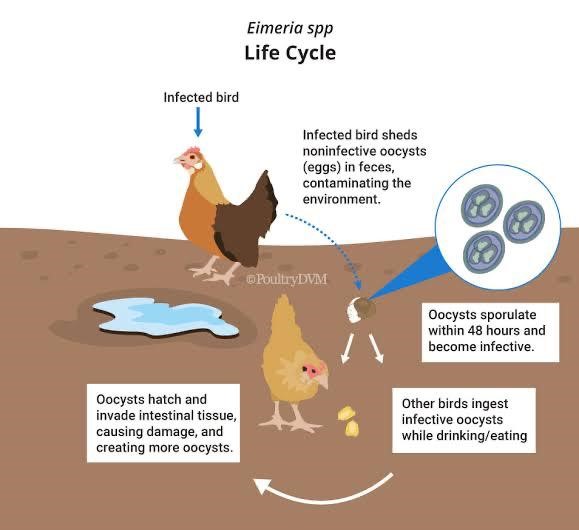Coccidiosis in Poultry
- Coccidiosis is a realistic problem and one of the most important diseases of poultry worldwide.
- a) The disease is considered as one of the most severe health and economical problems in poultry that causes an enormous loss to poultry producers worldwide
- The global cost of coccidiosis has been recently estimated to be >$3 billion per annum.
a) This cost calculation is based on direct production losses and indirect costs for prevention measures.
b) However, most of this financial loss comes from an increased feed conversion ratio (FCR) and decreased weight gain (Williams, 1999).
It is caused by a protozoan parasite known as Eimeria that invade the cells of the poultry intestine.
a) Species of coccidia which commonly affect poultry are Eimeria tenella, E. acervulina, E. necatrix, E. maxima and E. brunetti.
The disease is characterised by enteritis, diarrhoea and mortality.
a) The bird develops reduced ability to absorb nutrients, which results in weight loss and eventually death.
b) Subclinically, it is manifested by poor performance, impaired feed conversion, poor flock uniformity and poor growth.
Coccidia can also damage the immune system and leave poultry more vulnerable to pathogens like Clostridium, Salmonella and E. coli.
An outbreak of coccidiosis in a poultry flock has a very high negative and economical impact on the flock as well as for the poultry producer.
a) There is an immediate and considerable drop in production figures and the recovery and reestablishment period after treatment is slow.
b) Some flocks never fully recover or regain their full production potential.
b) Hence, it is a well-recognised fact that treatment alone cannot prevent the economical losses.
It is well established within the poultry sector that the only choice is therefore prevention of the disease.
Control:prevention with anticoccidial drugs.
a) producers may use one anticoccidial continuously through succeeding flocks, change to alternative anticoccidials every 4–6 months
b) or change anticoccidials during a single growout (ie, a shuttle program).
The ionophores
a) monensin,
b) salinomycin,
c) lasalocid,
d) narasin,
d) maduramicin,
e) and semduramicin
f) ionophores form complexes with various ions, principally sodium, potassium, and calcium, and transport these into and through biologic membranes.
g) The ionophores affect both extra- and intracellular stages of the parasite, especially during the early, asexual stages of parasite development.
Chemicals:
a) Clopidol is a coccidiostatic against early development of Eimeria spp by inhibiting mitochondrial energy production.
b) Nicarbazin was the first product to have truly broad-spectrum activity and has been in common use since 1955.
c) Robenidine, a guanidine compound, allows initial intracellular development of coccidia but prevents formation of mature schizonts.
d) Diclazuril is highly effective against a broad spectrum of coccidia.
Suitable products from Huvepharma having wide rangge of anti coccidial products are effective to treat, prevent and control Coccidiosis in Poultry.
a) ionophores:
Sacox- Salinomycin-12%
Poulcox- Monensin Sodium -20% and 40%
b) Chemicals:
Coyden- Clopidol -25%
Coxiril -0.5% – Diclazuril-0.5%
Amprol WS – Amprolium Hydrochloride-20%
c) combination of products:
Monicox- Monensin Sodium-8%
& Nicarbazine-8%
Nimax- Nibarbazine-16% &
Maduramycin- 1.5%
Please administer Huvepharma anti coccidial products as shuttle or by rotation to effectively treat, prevent and control coccidiosis in your poultry.
a) Supportive care:
Don’t forget that It is very important to keep the bird hydrated and comfortable.
b) Practice good sanitation and minimize accumulation of feces by cleaning at least once a week.
Dr V. Rajendra Prasad







